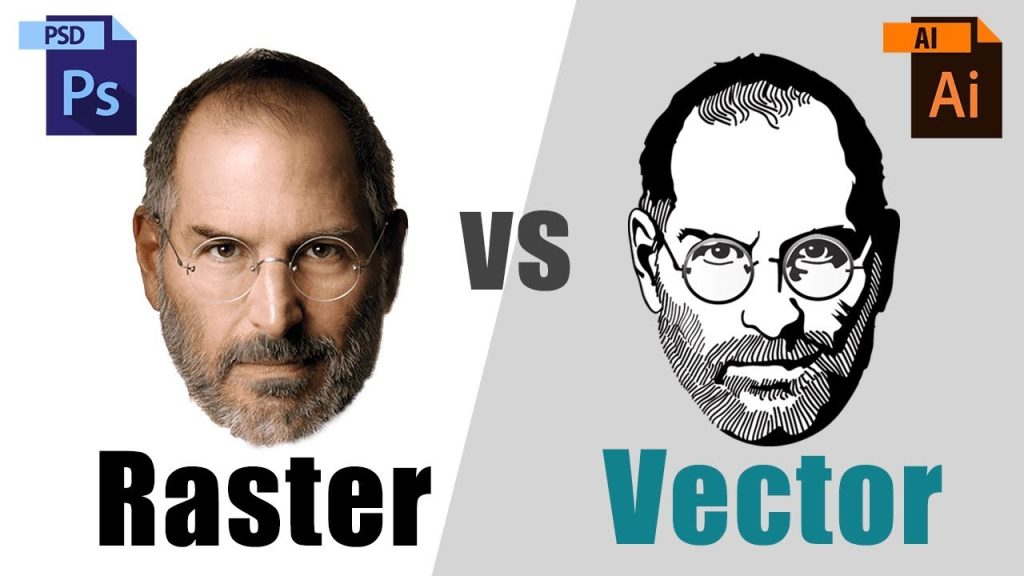Vector vs. Raster: Which Do I Use for Printing?

There are so many image options and file formats currently available that it is sometimes a bit overwhelming to choose the correct file type to use. Compatibility is always a concern when working with different file types. When it comes to graphics and images, the type of computer graphic format that is used is a vital aspect of the final representation of the image.
In general, there are two types of digital graphics files, and they are vector and raster. While vector images are made of hundreds of thousands of tiny lines and curves (or paths) to create an image, raster images are composed of pixels.
Let’s look at vector vs. raster images in order to determine how to tell which format is the best choice for your next print project
Raster Graphics
When it comes to raster graphics, the number of pixels or dots per inch makes the difference when it comes to image resolution (as well as how much it can be resized before it becomes distorted in appearance). The resolution of this type of image is measured according to the number of pixels per square inch of your photo or design AKA dots per inch (dpi).
When it is time to print custom products from raster art files, the resolution, or dots per inch, is needed for it to be properly formatted for print quality (300 dpi) at the desired size of the finished product. Please note that a higher resolution raster image keeps its crisp appearance if the artwork needs to be resized to print items such as posters or larger graphics.
Almost all images you find on websites are raster images (even images that might have originally been created with paths). It is important to remember that raster images are usually acceptable for digital publication, but they may not work well for printed projects. An important note: Raster images from the web are generally not suitable for print reproduction as they are often saved as low-resolution images. Of course you can purchase high resolution raster images from from companies such as Adobe Stock or iStock images that will work fine for many print projects.
If you know your raster artwork will be used for print, you’ll need to design images at 300 dpi resolution. It’s better to bring a raster image down in size than to try and make it larger or higher resolution. This this can cause pixelization or “stair-stepping” in your designs. Plus, designing raster-based artwork in CMYK process color achieves the best color matching results during the printing process. The most common use of a raster graphic is a photograph.
Vector Graphics
As opposed to raster images, vector artwork is designed to be infinitely scalable. In other words, the image edges will stay smooth and true to the design whether they are to be sized down or up. Vector artwork is designed using a more formulaic method and it works with lines and curves designed as designated paths within an image. The set points of the lines and curves, along each designated path, is what creates the design. Since the vector image elements are set as designated paths, they can easily be rescaled to any size without the design experiencing any distortion.
Vector graphics also have the advantage of file-size efficiency. Since the files are identified by mathematical descriptions, as opposed to individual pixels, the files will be much smaller than their raster counterparts. This makes vector images quite easy to transmit from one computer to another or to transfer them over the Internet.
The overall adaptability and file-size efficiency of vector graphics make this file format the ideal choice for print reproduction. In fact, a single vector image file can be used for multiple print projects such as a business card, website logo, or a sign that is printed for your business. The most common use for a vector graphic is a logo.
How Do I Know If My Image Is a Vector File
One of the most common questions that is asked regarding images for printing is:
”How can I tell if my image is in vector form?”
Keep in mind that one of the most common problems with the use of vector images is compatibility. Since vector images are often saved as native files from the program used to create the image, such as Adobe Illustrator, there is the possibility they are not available to everyone that needs to work with them. (Thankfully, widely compatible formats do exist). In addition, this also means the vector files might require special software to properly open.
Are you trying to determine if your artwork is a vector-based file? Here are a couple of things you can check:
- Enlarge the image significantly. If the edges remain smooth, and the text in the design retains its crisp lines and spacing, it’s probably vector-based.
- You can also take a look at the file extensions:
- Adobe Illustrator: .ai, .ait, .art
- Corel Draw: .cdr, .cdrw, .cdt
- Corel: pat (Paint Shop Pro Pattern Image)
- Digital Line Graph: .dlg, .do
- OpenOffice: .odg
To recap, vector graphics are the best choice for logos and illustrations while raster graphics are standard for digital photography. You should consider creating a vector image library for your files. You can save copies for raster-based work (in order to save time and manpower during the life of a project).
If you have any additional questions about the topic of vector vs. raster? Contact our Prepress team today to get the answers before you start your next project.
Contact Us for More Information
Are you looking for a printer who can help you meet your deadlines?
Then your in the right place! Have any questions or concerns we would love to hear from you.
Please submit your information in this form and a sales professional will reach out to you.
Want to Speak to a Sales Representative? Call 770-424-2300






